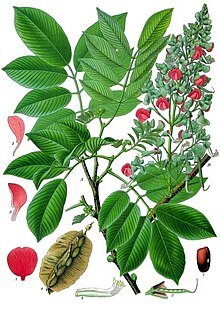Piscidia piscipula
| Florida fishpoison tree | |
|---|---|
 |
|
| Scientific classification | |
| Kingdom: | Plantae |
| (unranked): | Angiosperms |
| (unranked): | Eudicots |
| (unranked): | Rosids |
| Order: | Fabales |
| Family: | Fabaceae |
| Genus: | Piscidia |
| Species: | P. piscipula |
| Binomial name | |
|
Piscidia piscipula (L.) Sarg. |
|
| Synonyms | |
|
Piscidia erythrina L. |
|
Piscidia erythrina L.
Ichthyomethia piscipula (L.) Hitchc. ex Sarg.
Piscidia piscipula, formerly also called Piscidia erythrnia and commonly named Florida fishpoison tree, Jamaican dogwood, or fishfuddle, is a medium-sized, deciduous, tropical tree endemic to southern Florida, the Florida Keys, Texas, the Caribbean, and Latin America.Native Americans of the West Indies discovered extracts from the tree could sedate fish, allowing them to be caught by hand. This practice led to the tree's common names—fishpoison and fishfuddle. The tree has medicinal value as an analgesic and sedative.
The generic name is Latin for "fish killer", and the specific epithet is Latin for "little fish".
The Florida fishpoison tree grows in coastal zones. It prefers well-drained, sandy soils, with a top layer of humus. The tree has some tolerance to short-term storm surges of brackish water or seawater. Although it grows in coastal conditions, the tree is usually protected from direct salt spray by adjoining vegetation. Established trees are highly tolerant of drought. Its sensitivity to the cold limits Florida fishpoison tree to areas no colder than plant hardiness zone 11.
The Florida fishpoison tree attains medium size with heights of 12 to 15 m and bole diameters of 46 to 118 cm. An irregular, open crown develops with stout, erect branches.
Its deciduous leaves (9 to 23 cm long) are alternate and pinnately compound. Five to 11 leaflets (each 4 to 8 cm long) are present in an opposite arrangement. Leaflets are dark green above and distinctly paler grayish-green below with pubescence.
Its white flowers are tinged with red or pink. They appear in pea-like clusters in May and are attractive to bees. Trees potentially bloom when about 4 m tall and 4 years old. Flowers develop into a light brown, bean-like pod (8 to 10 cm long) with four papery wings. Ripening in July and August, the pods contain red-brown seeds with oval shapes.
...
Wikipedia
